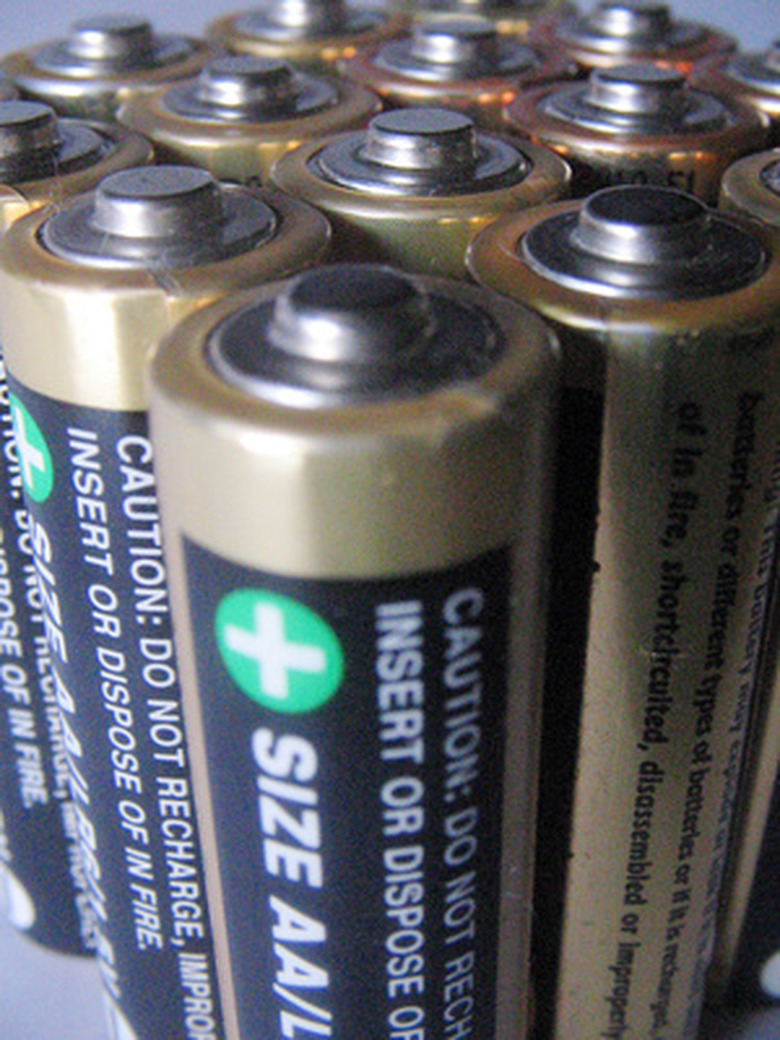Uses Of Dry Cell Batteries
The invention of the dry cell battery by Georges Leclanché in 1866 opened up a whole new world of innovation in technology. Since that time, dry cell batteries have found a myriad of uses as power sources. Materials such as nickel, carbon, cadmium, zinc and lead are used to manufacture different dry cell designs and capabilities.
Electronic Equipment
Dry cell batteries appear as the most commonly used battery type for powering electronic devices. According to Drexel University, the dry cell design comes in four different models, with some models more suitable for certain devices than others. Alkaline batteries carry 1.5 volts per cell. Sizes appear as AA, AAA, C, D and 9 volts. Alkalines provide high-capacity outputs and long shelf lives, which makes them ideal for small, handheld devices such as:
• calculators
• cameras
• clocks
• watches
Lithium batteries carry a 3-volt capacity per cell, though shelf life can vary depending on device usage. Devices such as cameras and smoke alarms work best with lithium batteries, due to the minimal outputs required with each use. Nickel-cadmium batteries produce 1.2 volts per cell, though these cells hold up better than alkalines under continual usage and the cells are rechargeable. Lead acid batteries resemble car batteries in terms of how they're packaged, with minimal leakage potential. Lead acid batteries carry a 2-volt output per cell, and like lithium batteries, work best with devices like CD players and camcorders which require minimal outputs when used.
Small Motors
Many small motor designs can run off of dry cell battery sources, which differ in size depending on the amount of current needed to power the motor. Direct current (DC) powered motors come in two designs–brush motors and brushless motors, according to ePanorama, a technology-based resource site. The two motor styles differ in how they change current when more power is needed. Brush motors rely on brushes to switch from one current to another, whereas brushless motors use electronic switching controls. Dry cell units direct the power needed for a motor to turn, which is how motors produce kinetic energy. Dry cell types used with small motor devices include nickel-metal hydride, lead acid gel and nickel-cadmium, according to Drexel University. Small motor engines appear in many different devices, some of which include power tools, robots, wheelchairs, golf carts and computer hard disks.
Large Motors
Dry cell batteries used in large motor designs fall within three usage categories–automotive, marine and deep cycle. According to Drexel University, hybrid automotive dry cell batteries consist of nickel metal halide, nickel metal hydride and lithium ion materials that allow for recharging on a regular basis. Marine-type designs appear within boats, RVs and military aircrafts. Deep-cycle cell designs function well as solar-electric power sources and generator power sources. According to the RV Resource Page, the differences in cell design appear within the way the cells harness the energy contained inside them. Different materials are used to construct the actual battery compartment or chamber. As a result, each category has a different usage capacity. An example of this is how the deep-cycle design allows for the constant high outputs required by generator devices.
Cite This Article
MLA
Jeanty, Jacquelyn. "Uses Of Dry Cell Batteries" sciencing.com, https://www.sciencing.com/uses-dry-cell-batteries-6955841/. 24 April 2017.
APA
Jeanty, Jacquelyn. (2017, April 24). Uses Of Dry Cell Batteries. sciencing.com. Retrieved from https://www.sciencing.com/uses-dry-cell-batteries-6955841/
Chicago
Jeanty, Jacquelyn. Uses Of Dry Cell Batteries last modified March 24, 2022. https://www.sciencing.com/uses-dry-cell-batteries-6955841/
